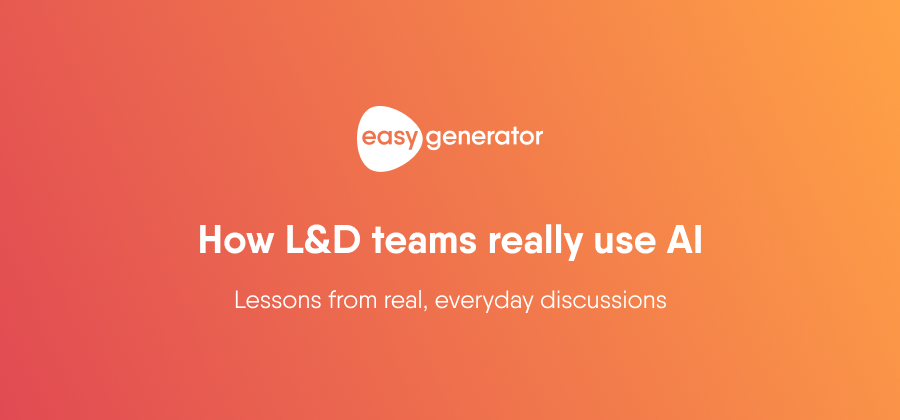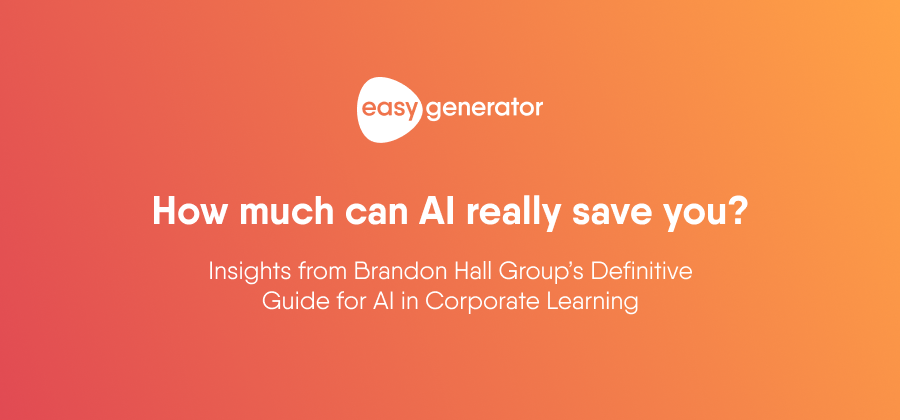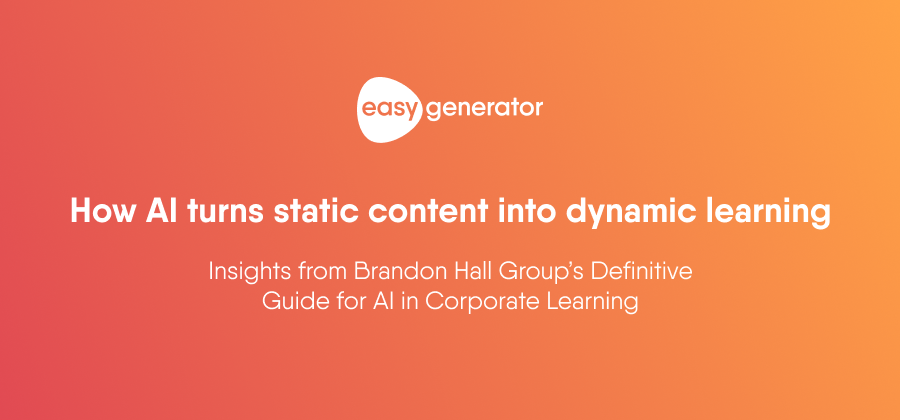E-learning content: Cost or value?
Elearning development costs are important when creating courses, but it shouldn’t be the only factor. While we’ll share the numbers, we’ll also highlight why benefits and business impact matter more than the price tag.

The cost perspective
When self-directed learning or e-learning first emerged in the 90s as “computer-based learning,” it revolutionized training by offering a cheaper alternative to traditional, in-person sessions. This cost-benefit led organizations to focus heavily on learning development costs, resulting in companies viewing their Learning & Development departments as cost centers.
Decisions to create learning and support materials are often based on saving costs. But this is an outdated perspective.
E-learning initiatives should be based not on price but on the added value they deliver to the organization. Of course, that added value should be greater than the cost of creating and hosting the e-learning.
In this article, we’ll look at this cost perspective, but we’ll also explore the value side of things.
How much does it cost to build an elearning course?
Elearning development costs involve a significant amount of time and money. Research by Kapp and Robyn Defelice shows that it can take between 90 and 240 hours to create one hour of e-learning material, depending on factors like course complexity and interactivity.
If you’re wondering how much does elearning cost, Raccoon Gang reported that the average cost of creating an hour of e-learning ranges from $10,000 to $30,000.
However, the cost of creation is only part of the story. Once your course is published, the expenses don’t end. As businesses evolve, your e-learning materials must keep pace to remain relevant, adding significant maintenance costs over time.
Create learning content faster and keep it up-to-date
The reason that elearning creation is expensive is that the L&D department creates learning materials. Instructional designers working in L&D are responsible for creating an elearning course. These designers have to interview subject matter experts (SMEs) from the business side to get the necessary information for the training content.
Turning all that information into digestible e-learning content involves deciphering conflicting inputs, verifying the collected data, and more. This is the main reason that e-learning content development is so slow. And because time is money, it’s also why creating e-learning content is so expensive. The process looks like this.
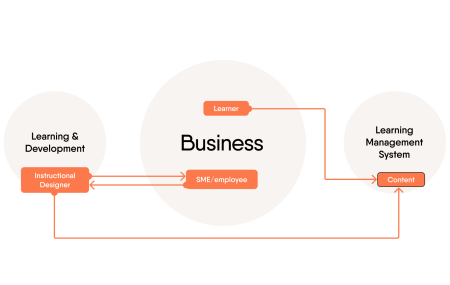
However, the cost of creation is not even the biggest issue. Most of the time, instructional designers who create these courses are also responsible for keeping them up to date. The problem is that they are unaware of any changes on the business side.
Making SMEs responsible for content creation and maintenance
Because of this, there is no trigger to update the course. They are unaware that the course is out of date. This is a fundamental flaw in the process that can only be fixed by making the SMEs on the business side responsible for the creation and maintenance. If you do that, the process looks like this:
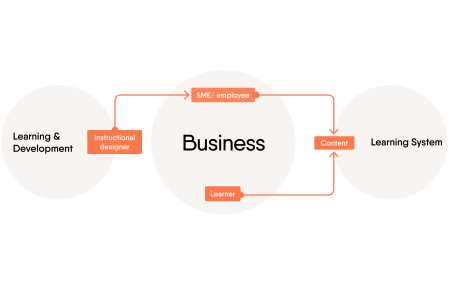
Because of the simplification of the process, creating learning content this way is much faster. We call this approach Employee-generated Learning (EGL). Our customers report that it can be up to ten times faster than the old instructional design approach. Because SMEs are also responsible for maintenance, we have solved that problem as well. Whenever something changes on the business side, they update and republish the course
Instructional designers continue to play an important role in this process. They can coach, help co-create, assist, and design. They can provide support to SMEs in all aspects, but they cannot assume responsibility for developing and maintaining learning materials.
Create e-learning content in-house
Outsourcing your e-learning production comes with many hidden costs. Our experts wrote a guide on how you can create e-learning in-house at a fraction of the cost.
We will review EGL’s four main components—strategy, people, tools, and content—to examine its value more closely.
1. Strategy
EGL streamlines your organization’s learning strategy in multiple ways, all of which leave a positive impact on your business:
Bottom-up approach
Unlike the top-down approach, where a central learning department is responsible for creating learning content for the organization, EGL enables a bottom-up approach where employees create content for each other. In other words, it enables employees to meet their own needs. Employees can apply their firsthand understanding of their peers’ needs in a way a central L&D team can’t. This creates a better alignment between the learning content and the learning needs it meets. And because employees are directly involved in the business, they’ll be tuned in to the latest updates, allowing them to maintain their learning content with the most relevant information easily.
| Value-added | Cost saved |
|
|
Employee-driven
Employees want to solve problems at work using information they can easily find, quickly understand, and—more importantly—instantly apply. When their peers create the learning content, employees can access tried and tested information immediately. This significantly reduces the amount of time it takes to transfer knowledge.
| Value-added | Cost saved |
|
|
Time to market
With employees creating the content, the speed of development and the time-to-market is much faster than with a top-down approach. Because SMEs themselves share the knowledge, there’s no need to validate the accuracy of the information externally, which can be a serious, time-consuming task. For example, because an instructional designer is no longer in charge of creating the content, it eliminates the need to reach out to an SME to fact-check their work.
| Value-added | Cost saved |
|
|
Business impact
Because EGL empowers employees to meet their learning needs more accurately than L&D can, they’ll be better equipped to perform their jobs well. This leaves a positive impact on both their KPIs and the business.
| Value-added | Cost saved |
|
|
2. People
L&D professionals and employees are the two key players driving EGL’s success. Let’s look at the unique value each of them brings:
L&D
Under EGL, L&D doesn’t need to be scurrying around, creating every tiny nugget of knowledge to meet everyone’s learning needs. Instead, as employees take the lead on content creation, L&D can take on a more supervisory role, facilitating the process and providing any support employees may need along the way. As an added benefit, the L&D team also gets more time to focus on essential projects that can’t be handed off to employees.
| Value-added | Cost saved |
|
|
Employees
As “Employee-generated Learning” suggests, employees are the primary drivers of knowledge-sharing. As experts on their subject matter, they’re qualified to validate their content. And because they’re plugged into daily business operations, they’re aware of notable business updates as soon as they’re announced, allowing them to update their content easily. In short, they’re responsible for organically creating, publishing, and maintaining the knowledge ecosystem.
| Value-added | Cost saved |
|
|
3. Creation process and tools
In addition to an effective strategy and the key players to drive it, you’ll need the right tools to create and maintain your learning content.
Process of creation and maintenance
When your employees take ownership of knowledge sharing, the development process becomes straightforward. SMEs create, share, and maintain the content themselves without the need for input or separate review sessions.
| Value-added | Cost saved |
|
|
Tools
With employees being both the creators and consumers of knowledge, there’s no need for complex authoring tools with unnecessary interactive elements. Under EGL, the goal is to be able to create content that effectively and efficiently enables on-the-job learning. This means it’s more important for employees to have user-friendly authoring tools that also allow for hassle-free maintenance. Easygenerator, for example, makes it easy for anyone to start creating learning content, even if they aren’t trained instructional designers.
| Value-added | Cost saved |
|
|
4. Content
Former Hewlett-Packard CEO, Lew Platt, once famously said, “If HP knew what HP knows, we’d be three times more productive.” This is the crux of EGL. By enabling those with firsthand knowledge of the business (SMEs) to create short content that shares specific information, they’ll be able to accelerate the circulation of relevant knowledge throughout the organization.
To give form and shape to the way you can share knowledge, we propose three primary formats based on what our customers generally ask for:
- Short courses
Being able to create short courses allows SMEs to provide a quick overview of their subject in multiple, digestible chapters. Don’t forget that SMEs are experts in their subjects and not in teaching, but their insights can lead to high-quality content. So, you don’t have to aim for perfection in content. It’s more important that you provide a structure that makes it easy for them to capture their knowledge. With an authoring tool like Easygenerator, you can make use of course templates that are easy to fill in and tailor to a specific topic. - Resources
Resources help accelerate on-the-job learning and serve as a valuable addition to formal training programs. For example, using Easygenerator, you can create short resources like this with How-To guides or Checklists. Easy-to-consume resources are most likely to appeal to employees because they are huge time-savers for performance support, so it is worth enabling this format. - Assessments
In case L&D wants to validate employee knowledge for compliance or practice purposes, provide simple authoring structures of basic quizzes to roll out assessments.
| Value-added | Cost saved |
|
|
Check out our tips for writing an e-learning course.
The value of e-learning outweighs the costs
In short, e-learning creates a lot of organizational value that far outweighs the costs. By replacing the time-consuming process of creating specialty e-learning courses with a scalable approach like EGL, you’ll be able to fulfill your employees’ learning needs more efficiently. This will empower them to simultaneously create more value for your organization at lower costs.
